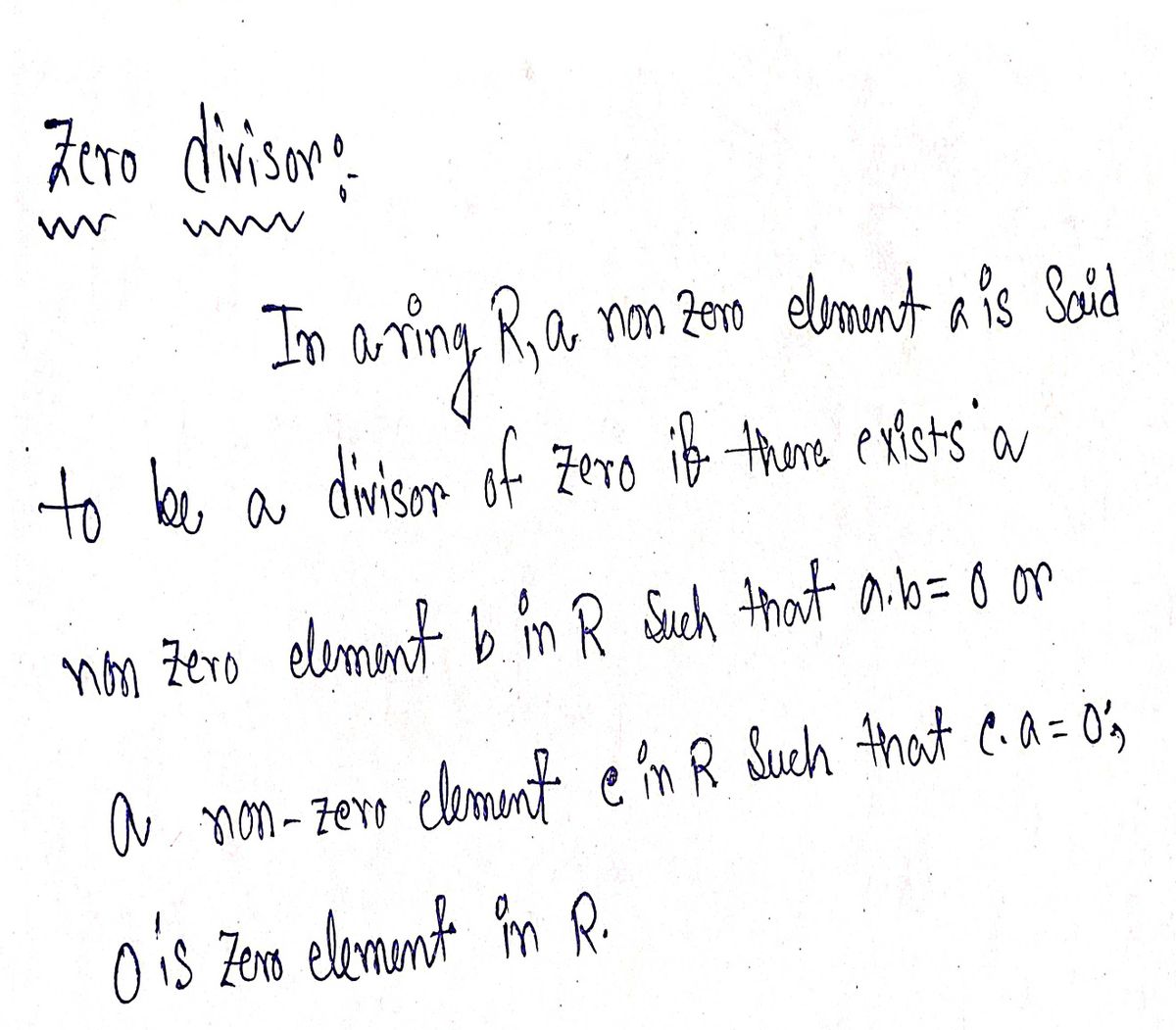Question 1. State whether True or False. Provide a reason in each case. (a) The pair (Z321.-) that consists of the set of congruence classes modulo 321 together with multiplication, has two zero divisors. (b) Every integral domain consists of an Abelian additive group, and a commutative unital ring which has a unity, but no zero divisors. (c) The set nZ for n € N, the set R\ Q. and the set C\R have no zero divisors.
Question 1. State whether True or False. Provide a reason in each case. (a) The pair (Z321.-) that consists of the set of congruence classes modulo 321 together with multiplication, has two zero divisors. (b) Every integral domain consists of an Abelian additive group, and a commutative unital ring which has a unity, but no zero divisors. (c) The set nZ for n € N, the set R\ Q. and the set C\R have no zero divisors.
Advanced Engineering Mathematics
10th Edition
ISBN:9780470458365
Author:Erwin Kreyszig
Publisher:Erwin Kreyszig
Chapter2: Second-order Linear Odes
Section: Chapter Questions
Problem 1RQ
Related questions
Question
![Question 1.
State whether True or False. Provide a reason in each case.
(a) The pair (Z321,-) that consists of the set of congruence classes modulo 321 together with
multiplication, has two zero divisors.
(b) Every integral domain consists of an Abelian additive group, and a commutative unital
ring which has a unity, but no zero divisors.
(c) The set nz for n N, the set R\Q, and the set C\R have no zero divisors.
(d) Given the set Z24 of congruence classes modulo 24. Then the congruence classes [2], [3], [4],
[6], [9], [12], [18], and [20] are some of the zeros divisors of Z24.
(e) The triple (Z[√-3], +,-) consisting of the set of algebraic numbers
Z[√-3] = {+ + √-3: for k, l, m, n € Z and I, n ‡ 0}
with operations of addition + and multiplication, constitutes an integral domain.
(f) The set of all functions M ([0,1]) from the the closed unit interval [0, 1] onto [0, 1],
together with usual function addition and function multiplication, does not have any zero
divisors. If you think it does, then give an example.](/v2/_next/image?url=https%3A%2F%2Fcontent.bartleby.com%2Fqna-images%2Fquestion%2Fb685f800-bd36-484b-82e6-b7cb9e75277f%2Fcf3d7b58-106b-4155-a26c-d22c79f0af63%2Fndtyp6_processed.png&w=3840&q=75)
Transcribed Image Text:Question 1.
State whether True or False. Provide a reason in each case.
(a) The pair (Z321,-) that consists of the set of congruence classes modulo 321 together with
multiplication, has two zero divisors.
(b) Every integral domain consists of an Abelian additive group, and a commutative unital
ring which has a unity, but no zero divisors.
(c) The set nz for n N, the set R\Q, and the set C\R have no zero divisors.
(d) Given the set Z24 of congruence classes modulo 24. Then the congruence classes [2], [3], [4],
[6], [9], [12], [18], and [20] are some of the zeros divisors of Z24.
(e) The triple (Z[√-3], +,-) consisting of the set of algebraic numbers
Z[√-3] = {+ + √-3: for k, l, m, n € Z and I, n ‡ 0}
with operations of addition + and multiplication, constitutes an integral domain.
(f) The set of all functions M ([0,1]) from the the closed unit interval [0, 1] onto [0, 1],
together with usual function addition and function multiplication, does not have any zero
divisors. If you think it does, then give an example.
Expert Solution
Step 1

Step by step
Solved in 5 steps with 5 images

Follow-up Questions
Read through expert solutions to related follow-up questions below.
Recommended textbooks for you

Advanced Engineering Mathematics
Advanced Math
ISBN:
9780470458365
Author:
Erwin Kreyszig
Publisher:
Wiley, John & Sons, Incorporated

Numerical Methods for Engineers
Advanced Math
ISBN:
9780073397924
Author:
Steven C. Chapra Dr., Raymond P. Canale
Publisher:
McGraw-Hill Education

Introductory Mathematics for Engineering Applicat…
Advanced Math
ISBN:
9781118141809
Author:
Nathan Klingbeil
Publisher:
WILEY

Advanced Engineering Mathematics
Advanced Math
ISBN:
9780470458365
Author:
Erwin Kreyszig
Publisher:
Wiley, John & Sons, Incorporated

Numerical Methods for Engineers
Advanced Math
ISBN:
9780073397924
Author:
Steven C. Chapra Dr., Raymond P. Canale
Publisher:
McGraw-Hill Education

Introductory Mathematics for Engineering Applicat…
Advanced Math
ISBN:
9781118141809
Author:
Nathan Klingbeil
Publisher:
WILEY

Mathematics For Machine Technology
Advanced Math
ISBN:
9781337798310
Author:
Peterson, John.
Publisher:
Cengage Learning,

